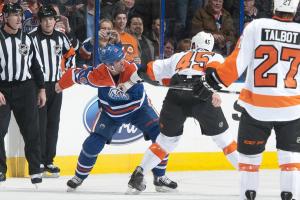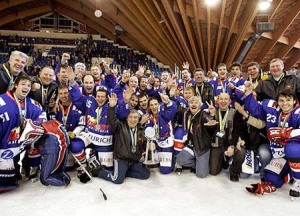 “We shape our tools,and then our tools shape us.” – Marshall McLuhan
“We shape our tools,and then our tools shape us.” – Marshall McLuhan
Influence of Technology on Sports Journalism
The impact of web technology has had a profound impact on how professional sports are consumed by fans. For example, fans have numerous options when they want to watch or listen to a game, including, among others, using mobile technology or data tracking software. Fans can interact and share content with others by publishing their thoughts and ideas about hockey on blogs and other social media platforms. To keep up with their loyal fan base, the NHL has readily adopted technology and software that helps their fans get closer to the game. Examples include providing detailed statistics available online or social media promotions to connect players to fans.
One area of professional sports that technology continues to strongly influence is sports journalism. Specifically, individuals who are employed by television broadcasters that hold NHL distribution rights, such as TSN or Sportsnet, newspapers and the NHL. These individuals typically have direct access to players and managers and are responsible for providing news and updates regarding NHL-related activity.
In the past, individuals who covered sports for the local news channel or newspaper were considered “reporters”. They would attend games and produce a story using the results of the event. Within the story would be quotes from players and coaches, a summary of key events within the game and maybe a preview of the next game. Since speculation is an important facet for professional sports, gossip regarding players and team could also be included, depending on the reporter.
Today, individuals who cover sports for mainstream media outlets are labeled all sorts of things. “Insiders”. “Analysts”. “Correspondents”. At first glance, they all appear to have the same role, which is to cover the game and provide some sort of content for fan consumption. But it’s the technology they use that differentiates them, as not all sports journalists produce the same kind of content. Understanding the tools they and what type of content they produce, can allow us to classify them and understand their roles and objectives.
Defining Reporting and Analysis
The technology sports journalists use differentiates those who report on the game, and those who analyze the game. Both “Reporting” and “Analyzing” are interchanged regularly, not only in sports journalism, but also other industries such as information management. While both actions produce content, they each entail different objectives.
I did a quick search online and came across this differentiation of Reporting and Analysis on a blog from Adobe, a major software company:
Reporting: The process of organizing data into informational summaries in order to monitor how different areas of a business are performing.
Analysis: The process of exploring data and reports in order to extract meaningful insights, which can be used to better understand and improve business performance.
So applying these definitions to sports journalism, I’ve come up with this:
Hockey Reporting: The process of coordinating data and information into summaries that describe hockey-related events. This is someone that summarizes current events, including games, player or team performance and current rumors.
Hockey Analysis: The process of exploring data and reports in order to extract meaningful insights, which can be used to better understand the game and support further analysis and continue extending the knowledge surrounding the game. This would be someone that could summarize current events, but spends more time looking deeper into the data from hockey games to provide further insight.
These definitions need some work, so I’m hoping to get feedback from anyone interested.
Why the need to classify sports journalists?
It’s critical for fans to understand the roles and objectives of the contents’ producer. The present environment for hockey fans contains a lot of information, and it’s really up to them to filter through the noise to find value in the content available online, in print and on television. Fans do more than just consume the content as they have demonstrated their ability to extend the content by providing their own feedback and raising new, applicable ideas.
By understanding the producers role, fans can put the content into perspective before extending the content and building new ideas. This is not to say that what sports reporters produce cannot be built upon by fans. But a more appropriate response can be made after understanding what the producers objectives are. And it’s much more beneficial to the game if ideas are built on solid claims and information, rather than bogus hockey rumors, for example.
As always, feel free to leave feedback below or contact me directly!
 Hockey analytics is doing some pretty remarkable stuff for the game. Not only are there new methods of understanding and following the game, but we’re beginning to see some of the more unintended consequences of its growth.
Hockey analytics is doing some pretty remarkable stuff for the game. Not only are there new methods of understanding and following the game, but we’re beginning to see some of the more unintended consequences of its growth. After being sent to the minors by the Edmonton Oilers, Darcy Hordichuk was recently interviewed by long time hockey writer, Jim Matheson. The
After being sent to the minors by the Edmonton Oilers, Darcy Hordichuk was recently interviewed by long time hockey writer, Jim Matheson. The 
